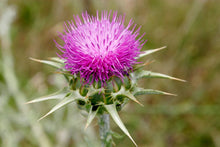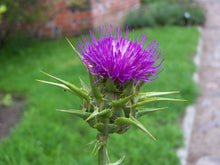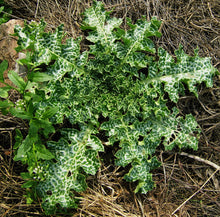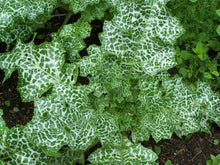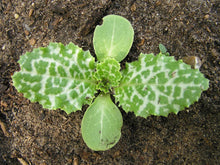
Common Name: blessed milkthistle
Type: Herbaceous perennial
Family: Asteraceae
Native Range: Southern Europe, Asia
Zone: 5 to 10
Height: 3.00 to 5.00 feet
Spread: 3.00 to 4.00 feet
Bloom Time: July to August
Bloom Description: Purple-pink
Sun: Full sun
Water: Medium
Maintenance: Medium
Suggested Use: Annual, Naturalize
Flower: Showy
Leaf: Colorful
Other: Thorns
Culture
Grow in average, moderately fertile, well-drained soils in full sun. Tolerates poor soils. Remove seed heads promptly after bloom to prevent self-seeding. This plant is a biennial that can be grown as an annual. For growth as a biennial, sow seed directly in the garden from May to August (flowers will not appear until the second year). For growth as an annual, sow seed indoors in March for planting outside at last spring frost date (flowers will appear in late summer followed by seed). Flowering plants may spread by self-seeding unless flowers are promptly deadheaded after bloom.
Noteworthy Characteristics
Silybum marianum, commonly called blessed thistle or milk thistle, is a rosette-forming biennial that is native to the Mediterranean region (southern Europe, western Asia and northern Africa). It has naturalized in parts of Europe, North America, South America, Australia and New Zealand. It is an invasive self-seeder in some locations (Class A noxious weed in the State of Washington). In the first year, a showy rosette of deeply lobed, obovate, spiny green leaves (to 20" long) with distinctive white marbling appears. Leaves and stems exude a milky sap when cut, hence the common name of milk thistle. In the second year, a strong flower stalk rises from the foliage rosette to 3-5' tall bearing thistle-like, mildly-scented, purple-pink flower heads (2" across) subtended by spiny bracts. Flowers are followed by seed as the plant completes its biennial (sometimes annual) life. An extract (silymarin) from the seeds of this plant has been used for many years in the treatment of a variety of medical problems including liver disorders, gall bladder disorders, high cholesterol and mushroom poisoning (especially from Amanita phalloides - death cap mushrooms).
Genus name comes from the Greek name silybon for some thistle-like plant.




